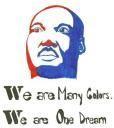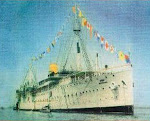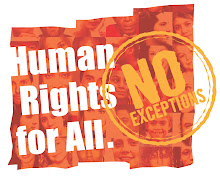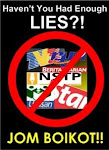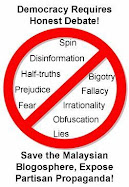This is what I observed at the peaceful assembly in front of the Istana Negara on 26 September 2009, which was called by
Hindraf and the
Human Rights Party Malaysia to deliver a petition to the the DYMM Yang Di-Pertuan Agong. The petition, which you can
download and read here, pleads to the YDP Agong for justice for Kugan and his family.
Eight months after his death in police custody, the killer/s of A. Kugan, have yet to be arrested and brought to justice.
I tried to get to the Istana Negara at about 10.30 a.m., but there was a police roadblock where Jalan Dewan Bahasa joins Jalan Istana, and the police were not allowing any cars to get past. I made some calls and found out that the petitioners were meeting at Naga's Restaurant in Brickfields, which is where I headed to.
Members of Kugan's family were already there, including Madam Indra (his mother), sister, brothers and uncle. With them were a small group of Hindraf and MHRP folks;
MP for Kapar YB S Manikavasagam,
MP for Puchong YB Gobind Singh Deo, and
ADUN for Kota Shah Alam YB M. Manoharan were also there. Soon, Human Rights Party Malaysia pro-tem secretary-general
P. Uthayakumar and Hindraf coordinator Mr. Jayathas arrived, and the group organised themselves for the trip to the istana.

Some of Kugan's family members waiting for transport to the Istana
I hitched a ride in one of the cars carrying some of Kugan's relatives. We set of towards the Istana, but somehow got separated from the lead cars. We parked before the roadblock at Jln Dewan Bahasa, and began walking towards the Istana proper.
Members of the police manning the roadblock blocked our way and told us that we could not pass.
The police stop us from proceeding
We told them that we were going to deliver a petition to the Istana, and that Kugan's relatives were with us. The policeman asked us to wait while he radioed his superiors for permission. He took an inordinate amount of time doing this.
Asking for instructions, or delaying tactics?
After about ten minutes of waiting with no indication of any permission forthcoming, our group decided not to wait there any longer, but to get back into our cars and try another route. By 11.30 we were walking towards the group of petitioners in front of the Istana.
The petitioners outside the Istana, outnumbered by the police, reporters and cameramen. By what stretch of the imagination could they have been considered a threat to public security?
As I approached this group at 11.33 a.m., a policeman was already ordering the crowd to disperse. This is what I managed to record:
Thus the people's attempt to express their plea for justice to their King was foiled by the police. The people there made their way back, and as you can see in the video above, their frustration and disappointment was evident.
The petitioners leaving the Istana area
The leaders of the petitioners had a quick discussion, and decided to hold a press conference back at Naga's Restaurant.
These are the people who prevented the rakyat from presenting their petition to DYMM YDP Agong. They are supposed to protect and serve the rakyat, but whose interests are they protecting now? Whose orders were they following?
Kugan's mother and other family members waiting by the roadside of Jalan Istana, having been chased away from the Istana area itself. Don't they have a right to plead for justice from their King, when the Malaysian AG and police have denied them justice for eight months? Why must they be treated so?
We got back into our cars and headed back to Naga's, where the impromptu press conference was held. Here are some video clips from it (apologies for the poor audio quality):
YB Gobind Singh Deo
YB M. Manoharan
Mr. Uthayakumar, YB Manickavasagam, YB Manoharan and lawyer Mr. N. Surendran
Madam Indra, with YB Manoharan translating for her. Kugan's mother still grieves.
YB Gobind Singh Deo again pt. 1
Pt. 2
Pt. 3
During the press conference, there were three gentlemen who were hanging about the restaurant, with a video camera. here they are, numbered accordingly:

I cannot verify this, but I was told that they were special branch officers. Here is another shot of them:
Here is number 3 recording the press conference from up close:

According to
this Bernama report of the event:
Brickfields police chief ACP Wan Abdul Bari Wan Abdul Khalid said police managed to disperse the gathering without any untoward incidents.
"No arrests were made. Police were on duty in front of Istana Negara to prevent incidents as the group comprised Hindraf members and politicians.
"The public should respect the residence of the Yang di-Pertuan Agong and the laws of the country," he said when contacted today.
Reading his statement, and having seen the events unfold for myself, these are the questions and thoughts that come to my mind:
1) What "untoward incident" was he expecting? Was he afraid that Kugan's mother was going to assault him with a deadly petition?
2) Why are Hindraf members and politicians singled out for "special treatment", when the
cow head protestors get a free pass? Blatant double standards at work!
3) What did any of the petitioners do there, which can be construed as disrespecting the YDP Agong or his residence? Palace officials had already been informed and were prepared to accept the memorandum. Isn't DYMM YDP Agong the King for all Malaysians, including for Kugan and his family? Wasn't His Majesty's palace built and maintained with their blood, sweat and tears as well? What laws did they break? Why is the Brickfields police chief slandering them?
4) Why aren't Malaysians allowed to exercise their right to assemble peacefully? Were these folks in any way or form a threat to public safety and security? If peaceful assemblies like these are broken up by the police, how else are Malaysians going to express their views and feelings? IMHO, all the while our 1Malaysia government is embarking on a "feel-good" PR campaign, they are severely eroding our rights to assemble peacefully, amongst many others. We need work urgently to re-establish our rights, before we lose them altogether.
5) Why was it that the people who showed up in support of the petition were virtually all Indians? In the past (for example during Kugan's funeral), there was heartwarming and encouraging support from all communities; we must never let such cooperation and understanding die away. Kugan's case, just like
Adi Anwar Mansor's and
Teoh Beng Hock's, is a serious issue for all Malaysians. If we only fight for justice when our own race is involved, then Umno/BN will win, because we cannot defeat them by ourselves. Civil society and progressive groups
must work together to find common ground and strive for change with a united voice. This will require high quality, principled leaders. United we stand; divided, we'll all die with Umno/BN in power for the next 52 years.
Please people, we must break down the racial walls that Umno/BN have built between us!6) We must ensure that the IPCMC is formed. IMHO, the police have become an instrument for the oppression of Malaysian's political expression and aspirations. If we are to have any hope of change in Malaysia, we must reform the police into an organisation that serves the rakyat, and not the political purposes of the party which happens to be in government.

The pain and anguish that our mothers bear for us, transcends time, language, race, and religion. Paradise lies beneath their feet, but all we give them in return is suffering. When our time comes, will God have mercy on us?
Sincerely,
Malaysian Heart
Please read more reports of the event
here,
here,
here and
here.


















































